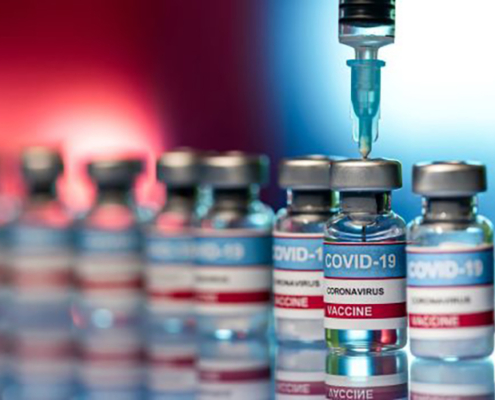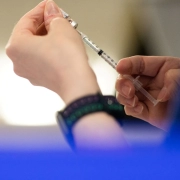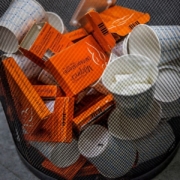On the Horizon, Needle-Free Vaccines could Offer Better Protection and Access
On the horizon, needle-free vaccines could offer better protection and access
Published: Oct 25, 2022
By Gail Dutton
BioSpace
Everyone is tired of being jabbed, but today, that’s the predominant option for vaccination. In the near future, however, the painful jab and muscle soreness that persists for days will be eliminated by needleless vaccines that – at least in some cases – provide more robust protection.
They also hold could eliminate the need for temperature-controlled storage and some of the accompanying medical infrastructure, helping to lower costs. These combined attributes make it easier to vaccinate populations in the developing world and to vaccinate children and adults who fear needles or are simply weary of getting shots.
Intradermal Delivery
“Improving the delivery system is another way to increase effectiveness of the vaccine,” said Chris Cappello, president and CEO of PharmaJet in an interview with BioSpace.
PharmaJet’s jet injection system is ready now. “We push the vaccine or the drug, which is a fluid, through a small aperture that controls the stream of vaccine, (constricting it into) a fine column about the size of one or two human hairs,” Capello said. “It penetrates the body in about one-tenth of a second.”
Importantly, the system can be tailored to deliver the vaccine or drug into the skin or into the muscle.
“We’re finding the skin is one of the best places to elicit immune responses,” Capello said. Intradermal injections, for instance, can use one-fifth the DNA dose used by intramuscular injection, yet elicit higher humoral and cellular responses.
This delivery method can be used for nucleic acid-based vaccines, where “we’re seeing stronger T cells and antibody responses,” he said, in addition to more traditional formulations. Although the exact responses vary by vaccine, “at a minimum, we’re showing non-inferiority, and in other instances, we’re seeing double or triple improvements in effectiveness.”
PharmaJet has more than 60 clinical and pharmaceutical partners and 80 clinical studies underway. The company just received a $1.5 million grant from USAID to evaluate needle-free injection for polio immunizations. It is also working with the World Health Organization for intradermal delivery of a polio vaccine, and the U.S. Defense Threat Reduction Agency to deliver a Venezuelan equine encephalitis DNA vaccine.
PharmaJet also recently began a licensure study on an mRNA vaccine for COVID-19 vaccine in India.
“The technology is commercialized,” he said. Now, “We’re focusing in areas where we can enable greater access to life-improving pharmaceuticals. There’s a shift toward intradermal delivery, and we want to be the global leader in that.”
Edible Vaccines
Edible vaccines are one of multiple options in development, and one of the most challenging due to the risk of degradation in the gut. Corn, rice, bananas, tomatoes, potatoes, lettuce, soybeans and even wheat have each been considered by various research groups. Regulatory approval, however, remains elusive.
Lumen Bioscience is engineering spirulina, a blue-green algae considered a superfood, to produce therapeutic proteins as an oral booster after a primary vaccination by other means.
“The recent paper in Nature NPJ Vaccines reflects success with an intranasal prime and an oral boost,” said Brian Finrow, J.D., CEO and co-founder of Lumen. As an initial vaccine, however, intranasal administration is more effective.
The research was conducted in collaboration with the University of Washington.
Lumen has clinical programs in Clostridioides difficile colitis, COVID-19 and traveler’s diarrhea, and preclinical programs in malaria, IBD and metabolic disease.
“Most of those are passive vaccines, in which you make the antibodies and fill the GI tract with them for a disease like C. difficile, rather than active vaccines like our malaria program,” Finrow said.
The company’s malaria vaccine recently achieved durable, sterile immunity in mice, and the NIH just funded the second phase of the program, taking it into non-human primates.
A benefit to using spirulina is its ease of production and breadth of applicability. Spirulina can be engineered to deliver protein biologics, including hormones, antibodies or cytokines, and can be produced using sterile vat fermentation. Taking it from the vat to finished product is mainly a matter of drying the spirulina biomass, performing a clarifying lysate to remove the cellular debris and then turning it into a dry powder.
Consequently, Jim Roberts, M.D., Ph.D., co-founder and CSO, told BioSpace, “It’s remarkably inexpensive to make…just pennies per dose.” Lumen’s 20,000 liter cGMP production capacity “is very easily scalable to address large commercial markets,” he said.
“We can manufacture enormous quantities of pretty much any kind of biologic molecule or protein therapeutic we care to make,” Finrow added. “We want to make so much of the (antibody or protein) that is pervasively available not just in the rich world, but in the very distributed areas of sub-Saharan Africa, Southeast Asia, etc.”
While Lumen did start its program with an edible vaccine, “The best option is to make an upper-airway inhalable vaccine to elicit a mucosal immune response,” Roberts continued.
With this approach, Lumen’s recombinant protein vaccine for malaria elicits not only a strong mucosal response but “the systemic immune response is as strong as the immune response you get by injecting the malaria parasite itself.” Whether that is true for all vaccines remains to be seen.
Intranasal Vaccines
Blue Water Vaccines is planning Phase I trials with its live attenuated intranasal vaccine, BWV-201, for acute otitis media (AOM) – middle ear infections and strep pneumonia.
“AOM is caused predominantly by strep pneumonia,” said Joseph Hernandez, chairman and CEO. “That causes morbidity and, long term, antibiotic resistance.”
The early work on an AOM vaccine was performed by researchers at St. Jude’s Children’s Hospital, and then in-licensed by Blue Water.
Needle-free delivery is important, Hernandez said, because, “Kids get vaccinated a lot, so introducing another vaccine that has a needle component to it isn’t exactly attractive. The other aspect is biological.
“We first encounter strep pneumonia in the nasal cavity. Because of that, mucosal immunity is very important because that immunity is different from cell-mediated immunity, which is what occurs after an intramuscular injection.”
Biologically, therefore, it makes sense to deliver a respiratory disease vaccine intranasally, where the virus is first encountered.
So far, Blue Water has conducted animal studies in mice and chinchilla (which behave very similarly to humans with middle ear infections).
“The data shows, consistently and predictably, that we can create a mucosal immune response to the bacteria and further, that it inhibits the ability for these bacteria to colonize the middle ear. More importantly, it reduces the cause of middle early infections in these animal models. Now we have to test that in humans.”
Recently, Blue Water released data around pneumonia infections in the lung, showing the ability of its vaccine to prevent polymerization of bacteria there.
“We saw some great signals,” Hernandez said. A clinical trial looking at middle ear infections in the pediatric population and lung pneumonia for a broader pediatric and adult population is being planned for 2023.
Currently, the vaccine is delivered as a liquid aerosolized form, although Blue Water is considering ways to preserve it longer, possibly through lyophilization.
These are just a few of the companies advancing needleless vaccine delivery systems. Routine use, however, remains on the near horizon. For this season’s influenza and COVID-19 boosters, most of us can still expect a jab.
Source: BioSpace











